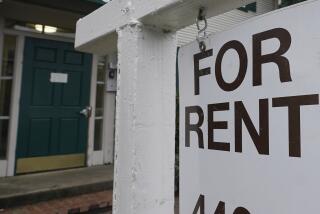Lending to Minorities Examined
- Share via
In an effort to close the homeownership gap between whites and minorities, Rep. Barbara Lee (D-Oakland) has requested a meeting this month with Federal Reserve Chairman Alan Greenspan, banking regulators and high-ranking Bush administration officials to question the Community Reinvestment Act rating system.
The rating system tracks and evaluates a bank’s performance in making loans to low-income home buyers. Under the current system, which Greenspan endorsed in a recent hearing, many of the largest banks in California--those with $10 billion or more in assets--have received “outstanding” lending grades, even when less than 3% of those banks’ conventional home loans went to African Americans.
A conventional home loan is a loan that is at or below the Fannie Mae/Freddie Mac conforming loan limit of $300,700 and written to their standards.
The lending pattern for Latinos was about the same, according to a study conducted by the Greenlining Institute, an alliance of church, consumer, civil rights and small-business groups based in San Francisco.
“Homeownership is the only way of acquiring equity and achieving the American dream,” Lee said. “We need to see how these ratings are evaluated and make sure homeownership rates increase in the minority communities.”
Lee asked the Greenlining Institute to analyze home-lending data provided by the Federal Reserve Board, in response to Greenspan’s comments at a July appearance before Congress’ Financial Services Committee.
At that hearing, the Fed chairman said that the reinvestment act rating system is an effective method to influence banks to increase lending to underserved minorities.
The Greenlining Institute’s analysis revealed, however, that of the 13 major banks that made more than 200 conventional home loans in California in 2000, the majority provided less than 3% of those loans to African Americans. Despite these low percentages, all of the institutions making less than 3% received either an “outstanding” or “high satisfactory” grade on the rating system’s lending test.
Citibank ranked lowest in the percentage of conventional home loans to Latinos, less than 5%. Yet it, too, received an “outstanding” CRA rating. United Bank of California received a “high satisfactory” rating, although less than 1% of its conventional home loans went to African Americans, according to the report.
“When you euphorically state that banks are doing a good job, the pressure is taken off those banks to increase the number of home loans they make to minorities,” said Robert Gnaizda, general counsel for the Greenlining Institute. “If we can change the CRA rating system, I believe it would double, at a minimum, the number of home loans made to African Americans, Latinos and Southeast-Asian Americans over the next three years.”
Bob McNeely, the community reinvestment officer at Union Bank of California, said that the reinvestment act rating system is an income-based instrument that evaluates how banks lend and reinvest in low-income communities; it is not racially or ethnically based.
“Under the law, it is illegal to ask information about race, so we can’t track it; that was instituted so that banks would be blind in their decisions about lending,” McNeely said. “Rep. Lee’s heart is in the right place, but at the end of the day, she happens to be targeting the wrong law to try to affect change. It would be better to create a new one.”
McNeely added that Union Bank of California has placed community development officers in low-income neighborhoods to help provide homeowner counseling and other outreach activities.
The bank also provides “equal opportunity” loans that are one-eighth below the market rate for similar loans.
Washington Mutual, which made 1.9% of its 1999 home loans in California to African Americans and 13.2% to Latinos, has made a commitment to double that number over the next two years.
It also has earmarked $375 billion nationwide for single-family home loans to borrowers earning less than 80% of the area median income, said Bob Flowers, president of community investment and development for Washington Mutual.
Bank of America, whose percentage of home loans to Latinos dipped to 16.5% in 2000 from 18.5% a year earlier, made a 10-year, $350-billion commitment in 1998 to invest in low- and moderate-income communities nationwide, said Bank of America spokeswoman Julie Davis.
In a Feb. 20 letter to Greenspan, Lee recommended that the Senate and House hold hearings at which bank regulators could explain their grades, and financial institutions and community groups would have an opportunity to offer suggestions about closing the homeownership gap.
“Our goal is to increase minority homeownership, period,” Lee said. “It’s good for the banks and good for the families.”
*
(BEGIN TEXT OF INFOBOX)
Conventional Home Lending by Bank
(text of infobox not included)
More to Read
Inside the business of entertainment
The Wide Shot brings you news, analysis and insights on everything from streaming wars to production — and what it all means for the future.
You may occasionally receive promotional content from the Los Angeles Times.










